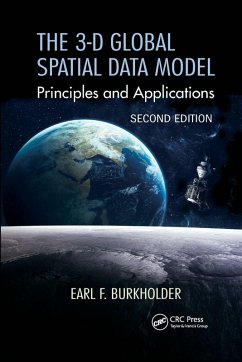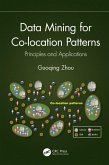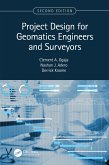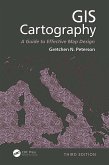- Broschiertes Buch
- Merkliste
- Auf die Merkliste
- Bewerten Bewerten
- Teilen
- Produkt teilen
- Produkterinnerung
- Produkterinnerung
This new second edition demystifies the concepts of spatial data accuracy and provides mathematical clarity to issues of network accuracy and local accuracy. Ideal for both beginner and advanced levels, this book also provides guidance and insight on how to link to the data collected and stored in legacy systems.
Andere Kunden interessierten sich auch für
![Big Data Concepts, Technologies, and Applications Big Data Concepts, Technologies, and Applications]() Mohammad Shahid HusainBig Data Concepts, Technologies, and Applications68,99 €
Mohammad Shahid HusainBig Data Concepts, Technologies, and Applications68,99 €![Business Intelligence and Big Data Business Intelligence and Big Data]() Celina OlszakBusiness Intelligence and Big Data111,99 €
Celina OlszakBusiness Intelligence and Big Data111,99 €![Data Mining for Co-Location Patterns Data Mining for Co-Location Patterns]() Guoqing ZhouData Mining for Co-Location Patterns154,99 €
Guoqing ZhouData Mining for Co-Location Patterns154,99 €![Project Design for Geomatics Engineers and Surveyors, Second Edition Project Design for Geomatics Engineers and Surveyors, Second Edition]() Clement Ogaja (California State University, Fresno, USA)Project Design for Geomatics Engineers and Surveyors, Second Edition115,99 €
Clement Ogaja (California State University, Fresno, USA)Project Design for Geomatics Engineers and Surveyors, Second Edition115,99 €![Making Data Work Making Data Work]() Edosa OdaroMaking Data Work47,99 €
Edosa OdaroMaking Data Work47,99 €![Making Data Work Making Data Work]() Edosa OdaroMaking Data Work116,99 €
Edosa OdaroMaking Data Work116,99 €![GIS Cartography GIS Cartography]() Gretchen N. Peterson (PetersonGIS, Seattle, Washington, USA)GIS Cartography64,99 €
Gretchen N. Peterson (PetersonGIS, Seattle, Washington, USA)GIS Cartography64,99 €-
-
-
This new second edition demystifies the concepts of spatial data accuracy and provides mathematical clarity to issues of network accuracy and local accuracy. Ideal for both beginner and advanced levels, this book also provides guidance and insight on how to link to the data collected and stored in legacy systems.
Hinweis: Dieser Artikel kann nur an eine deutsche Lieferadresse ausgeliefert werden.
Hinweis: Dieser Artikel kann nur an eine deutsche Lieferadresse ausgeliefert werden.
Produktdetails
- Produktdetails
- Verlag: Taylor & Francis Ltd
- 2 ed
- Seitenzahl: 528
- Erscheinungstermin: 30. September 2020
- Englisch
- Abmessung: 234mm x 156mm x 27mm
- Gewicht: 786g
- ISBN-13: 9780367872991
- ISBN-10: 0367872994
- Artikelnr.: 60006998
- Herstellerkennzeichnung
- Libri GmbH
- Europaallee 1
- 36244 Bad Hersfeld
- gpsr@libri.de
- Verlag: Taylor & Francis Ltd
- 2 ed
- Seitenzahl: 528
- Erscheinungstermin: 30. September 2020
- Englisch
- Abmessung: 234mm x 156mm x 27mm
- Gewicht: 786g
- ISBN-13: 9780367872991
- ISBN-10: 0367872994
- Artikelnr.: 60006998
- Herstellerkennzeichnung
- Libri GmbH
- Europaallee 1
- 36244 Bad Hersfeld
- gpsr@libri.de
A native Virginian, Earl F. Burkholder grew up in Virginia's Shenandoah Valley and graduated from Eastern Mennonite High School in 1964. He earned a BS in civil engineering from the University of Michigan, Ann Arbor, Michigan, in 1973 and an MS in civil engineering (Geodesy) in 1980. From 1980 to 1993, he taught upper division surveying classes at the Oregon Institute of Technology, Klamath Falls, Oregon. After five years of being self-employed, he taught in the Surveying Engineering program at New Mexico State University from 1998 to his retirement in 2010. His professional career began as a draftsman with Gould Engineering, Inc. of Flint, Michigan in 1968. Following graduating from University of Michigan, Ann Arbor, Michigan, he worked five years for Commonwealth Associates, Inc. of Jackson, Michigan, an international consulting firm for the utility industry. Assigned to the Transmission Line Engineering Division at Commonwealth, he was responsible for surveying related computations on projects in numerous states and was promoted to Survey Project Manager prior to leaving in 1978 to attend Purdue University. While teaching at Oregon Tech, he became editor of the ASCE Journal of Surveying Engineering and served two separate four-year terms; 1985-1989 and 1993-1998. He also became involved in ABET accreditation activities while at Oregon Tech and went on to serve on the Engineering Related Accreditation Commission (now known as the Applied Science Accreditation Commission) culminating as chair of the RAC in 2000/2001. While self-employed, he completed three major projects for the Southeastern Wisconsin Regional Planning Commission (SEWRPC), Waukesha, Wisconsin. The first project was to develop a reliable bidirectional algorithm for transforming data between the NAD 27 datum being used by SEWRPC and the new NAD 83 datum published by the National Geodetic Survey (NGS). Upon successful completion of the horizontal transformation
Foreword. Preface to the Second Edition. Preface to the First Edition.
Acknowledgments. Author. List of Abbreviations. Chapter 1 The Global
Spatial Data Model (GSDM) Defined. Chapter 2 Featuring the 3-D Global
Spatial Data Model. Chapter 3 Spatial Data and the Science of Measurement.
Chapter 4 Summary of Mathematical Concepts. Chapter 5 Geometrical Models
for Spatial Data Computations. Chapter 6 Overview of Geodesy. Chapter 7
Geometrical Geodesy. Chapter 8 Geodetic Datums, Chapter 9 Physical Geodesy.
Chapter 10 Satellite Geodesy and Global Navigation Satellite Systems.
Chapter 11 Map Projections and State Plane Coordinates. Chapter 12 Spatial
Data Accuracy. Chapter 13 Using the GSDM to Compute a Linear Least Squares
GNSS Network. Chapter 14 Computing Network Accuracy and Local Accuracy
Using the Global Spatial Data Model. Chapter 15 Using the GSDM-Projects and
Applications. Appendix A: Rotation Matrix Derivation. Appendix B: 1983
State Plane Coordinate Zone Constants. Appendix C: 3-D Inverse with
Statistics. Appendix D: Development of the Global Spatial Data Model
(GSDM). Appendix E: Evolution of Meaning for Terms: Network Accuracy and
Local Accuracy. Index.
Acknowledgments. Author. List of Abbreviations. Chapter 1 The Global
Spatial Data Model (GSDM) Defined. Chapter 2 Featuring the 3-D Global
Spatial Data Model. Chapter 3 Spatial Data and the Science of Measurement.
Chapter 4 Summary of Mathematical Concepts. Chapter 5 Geometrical Models
for Spatial Data Computations. Chapter 6 Overview of Geodesy. Chapter 7
Geometrical Geodesy. Chapter 8 Geodetic Datums, Chapter 9 Physical Geodesy.
Chapter 10 Satellite Geodesy and Global Navigation Satellite Systems.
Chapter 11 Map Projections and State Plane Coordinates. Chapter 12 Spatial
Data Accuracy. Chapter 13 Using the GSDM to Compute a Linear Least Squares
GNSS Network. Chapter 14 Computing Network Accuracy and Local Accuracy
Using the Global Spatial Data Model. Chapter 15 Using the GSDM-Projects and
Applications. Appendix A: Rotation Matrix Derivation. Appendix B: 1983
State Plane Coordinate Zone Constants. Appendix C: 3-D Inverse with
Statistics. Appendix D: Development of the Global Spatial Data Model
(GSDM). Appendix E: Evolution of Meaning for Terms: Network Accuracy and
Local Accuracy. Index.
Foreword. Preface to the Second Edition. Preface to the First Edition.
Acknowledgments. Author. List of Abbreviations. Chapter 1 The Global
Spatial Data Model (GSDM) Defined. Chapter 2 Featuring the 3-D Global
Spatial Data Model. Chapter 3 Spatial Data and the Science of Measurement.
Chapter 4 Summary of Mathematical Concepts. Chapter 5 Geometrical Models
for Spatial Data Computations. Chapter 6 Overview of Geodesy. Chapter 7
Geometrical Geodesy. Chapter 8 Geodetic Datums, Chapter 9 Physical Geodesy.
Chapter 10 Satellite Geodesy and Global Navigation Satellite Systems.
Chapter 11 Map Projections and State Plane Coordinates. Chapter 12 Spatial
Data Accuracy. Chapter 13 Using the GSDM to Compute a Linear Least Squares
GNSS Network. Chapter 14 Computing Network Accuracy and Local Accuracy
Using the Global Spatial Data Model. Chapter 15 Using the GSDM-Projects and
Applications. Appendix A: Rotation Matrix Derivation. Appendix B: 1983
State Plane Coordinate Zone Constants. Appendix C: 3-D Inverse with
Statistics. Appendix D: Development of the Global Spatial Data Model
(GSDM). Appendix E: Evolution of Meaning for Terms: Network Accuracy and
Local Accuracy. Index.
Acknowledgments. Author. List of Abbreviations. Chapter 1 The Global
Spatial Data Model (GSDM) Defined. Chapter 2 Featuring the 3-D Global
Spatial Data Model. Chapter 3 Spatial Data and the Science of Measurement.
Chapter 4 Summary of Mathematical Concepts. Chapter 5 Geometrical Models
for Spatial Data Computations. Chapter 6 Overview of Geodesy. Chapter 7
Geometrical Geodesy. Chapter 8 Geodetic Datums, Chapter 9 Physical Geodesy.
Chapter 10 Satellite Geodesy and Global Navigation Satellite Systems.
Chapter 11 Map Projections and State Plane Coordinates. Chapter 12 Spatial
Data Accuracy. Chapter 13 Using the GSDM to Compute a Linear Least Squares
GNSS Network. Chapter 14 Computing Network Accuracy and Local Accuracy
Using the Global Spatial Data Model. Chapter 15 Using the GSDM-Projects and
Applications. Appendix A: Rotation Matrix Derivation. Appendix B: 1983
State Plane Coordinate Zone Constants. Appendix C: 3-D Inverse with
Statistics. Appendix D: Development of the Global Spatial Data Model
(GSDM). Appendix E: Evolution of Meaning for Terms: Network Accuracy and
Local Accuracy. Index.








